The Living Apsaras of Cambodia
If you've ever been to the ruins of Angkor Wat, chances are that you'd have noticed the Apsara carvings that adorn the walls all around the temple remains. Traditional Khmer classical dancers bear more than a passing resemblence to these bas-reliefs and are often referred to as Apsara dancers, a somewhat inaccurate term but generally accepted nonetheless. The dance dates back to the Angkor period when court dancers performed in the thousands. Its long history was disrupted when in the post Angkor period, Cambodia was absorbed as a vassal state of Siam and much of its cultural identity was lost. The modern day revival of Khmer dance came about in the post WW2 period when the royal court under the auspices of then Queen of Cambodia, Kossamak Nearireath, sought to reintroduce the art form in Cambodia by reestablishing the Royal Ballet of Cambodia.
More recently, Khmer classical dance was put to a stop when Pol Pot and his Khmer Rouge regime gained power in the 1970s. Thousands of dancers lost their lives in the genocide which followed and many thought that the art would be lost forever. The surviving dancers banded together after the Khmer Rouge fell from power and under the direction of HRH Princess Norodom Bopha Devi, a renowned Apsara dancer herself, brought about yet another rebirth of the dance in modern day Cambodia.
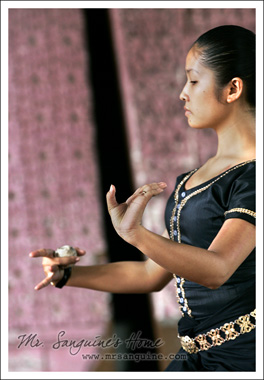
Apsara dance today lives on in the form of the Royal Ballet of Cambodia and other professional dance troupes, in Cambodia and other places around the globe. I was fortunate enough (thanks Chivan!) to be permitted to observe a practice session with the principal troupe of the Royal Ballet while in Phnom Penh and these images are from the 2 short hours which I spent with them.
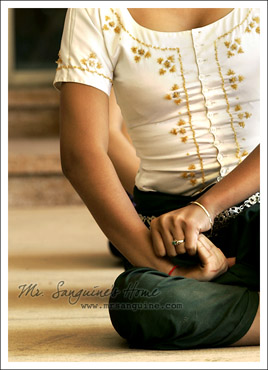
The dance form is often characterised by delicate and complex hand gestures which represent various meanings or things. Great flexibility is required and the dancers will start a session off by stretching their fingers and limbs. I witnessed some of the dancers pulling their fingers far back enough to touch their forearms.
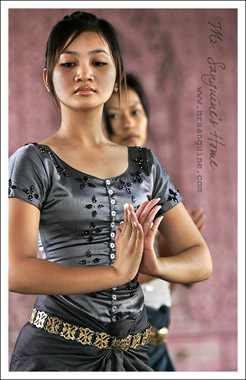
Performance costumes are far more elaborate than what is worn during rehersals.
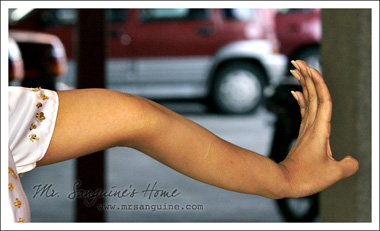
A rather mind boggling pose, it's a real joy to watch such contorted movements performed with such grace and finesse. Do not try this at home folks.
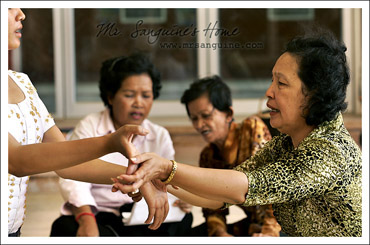
An instructor provides guidance to a young Apsara dancer. The two ladies in the background provided the musical accompaniment which included lyrics which are sung. The lyrics describe the story of the dance and are usually accompanied by a full ensemble of gongs, xylophones and other traditional musical instruments during actual performances.
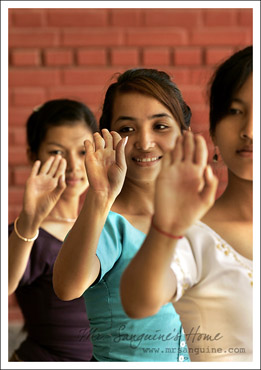
Dancers are selected at a tender young age and put through a regime of dance training as well as schooling. Many of the principal dancers have been with the Royal Ballet for 10 years or more.
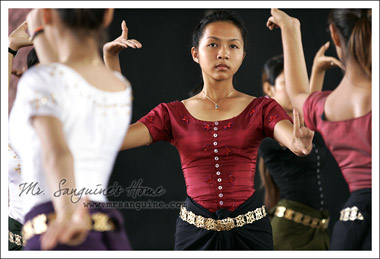
After painstakingly seeking out the old dance teachers from around the country, and bringing them together to train a new generation of artistes, Princess Norodom Bopha Devi is said to almost have brought Khmer dance once again to its pre-Khmer Rouge level of skill and artistry.
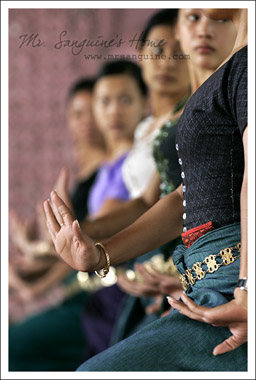
A chorus line of a different sort.
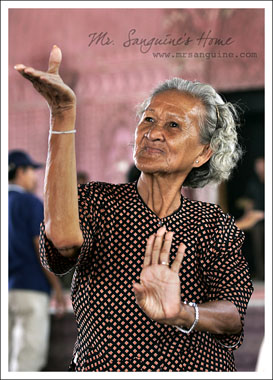
At 75 and still going strong. This former dancer recounted the Khmer Rouge years where she avoided attention and possible death by practising the hand gestures of the dance as she lay in bed each night.
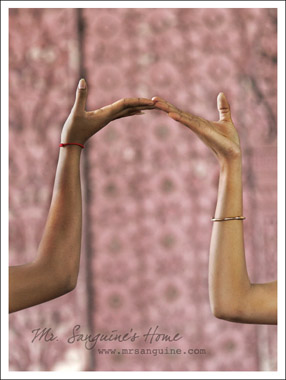
My time spent with the dancers of the Royal Ballet was one of the many highlights of my visit to Phnom Penh. If you're in Siem Reap in November of this year, be sure to look out for the Royal Ballet dancers as they perform at Angkor Wat during a week long festival to be held there. Ironically, as the beautfiul ruins of Angkor are increasingly overrun by tourists, we might find Apsara dance to be the real remaining untouched treasure of Cambodia left in coming years.
More recently, Khmer classical dance was put to a stop when Pol Pot and his Khmer Rouge regime gained power in the 1970s. Thousands of dancers lost their lives in the genocide which followed and many thought that the art would be lost forever. The surviving dancers banded together after the Khmer Rouge fell from power and under the direction of HRH Princess Norodom Bopha Devi, a renowned Apsara dancer herself, brought about yet another rebirth of the dance in modern day Cambodia.

Apsara dance today lives on in the form of the Royal Ballet of Cambodia and other professional dance troupes, in Cambodia and other places around the globe. I was fortunate enough (thanks Chivan!) to be permitted to observe a practice session with the principal troupe of the Royal Ballet while in Phnom Penh and these images are from the 2 short hours which I spent with them.

The dance form is often characterised by delicate and complex hand gestures which represent various meanings or things. Great flexibility is required and the dancers will start a session off by stretching their fingers and limbs. I witnessed some of the dancers pulling their fingers far back enough to touch their forearms.

Performance costumes are far more elaborate than what is worn during rehersals.

A rather mind boggling pose, it's a real joy to watch such contorted movements performed with such grace and finesse. Do not try this at home folks.

An instructor provides guidance to a young Apsara dancer. The two ladies in the background provided the musical accompaniment which included lyrics which are sung. The lyrics describe the story of the dance and are usually accompanied by a full ensemble of gongs, xylophones and other traditional musical instruments during actual performances.

Dancers are selected at a tender young age and put through a regime of dance training as well as schooling. Many of the principal dancers have been with the Royal Ballet for 10 years or more.

After painstakingly seeking out the old dance teachers from around the country, and bringing them together to train a new generation of artistes, Princess Norodom Bopha Devi is said to almost have brought Khmer dance once again to its pre-Khmer Rouge level of skill and artistry.

A chorus line of a different sort.

At 75 and still going strong. This former dancer recounted the Khmer Rouge years where she avoided attention and possible death by practising the hand gestures of the dance as she lay in bed each night.

My time spent with the dancers of the Royal Ballet was one of the many highlights of my visit to Phnom Penh. If you're in Siem Reap in November of this year, be sure to look out for the Royal Ballet dancers as they perform at Angkor Wat during a week long festival to be held there. Ironically, as the beautfiul ruins of Angkor are increasingly overrun by tourists, we might find Apsara dance to be the real remaining untouched treasure of Cambodia left in coming years.
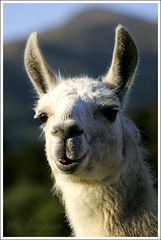



OUCH! I was with you until that "contorsionist" pose. [Shudder]
Did you know babies can bend their fingers back to touch their forearms? Try it next time, and if it does not work, RUN!
Posted by Kewl Nitrox |
September 26, 2006 2:59 AM
Kewl Nitrox |
September 26, 2006 2:59 AM
This art is so beautiful! My moms learn to dance the ballet then went through a time of fear for knowing it! Much support!
QUALEA.
Posted by Anonymous |
July 02, 2007 7:31 AM
Anonymous |
July 02, 2007 7:31 AM
This art is so beautiful! My moms learn to dance the ballet then went through a time of fear for knowing it! Much support!
QUALEA.
Posted by Anonymous |
July 02, 2007 7:31 AM
Anonymous |
July 02, 2007 7:31 AM